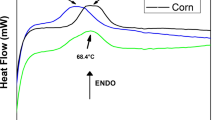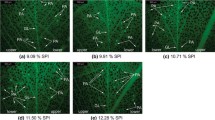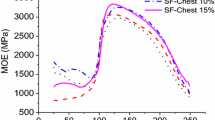Abstract
This work was to correlate physical properties with adhesion properties of soy protein-based adhesives. By building such a correlation, the adhesion properties can be predicted by measuring physical properties of soy protein-based adhesives. In this context, three important physical properties, viscosity, tacky force, and water resistance, were selected to correlate with adhesion strength of enzymatically modified soy protein-based adhesives (ESP). Response surface methodology, specifically central composite design, was used with three independent variables to prepare ESP: trypsin concentration (X 1), incubation time (X 2), and glutaraldehyde (GA) concentration (X 3). The three physical properties measured were all greatly affected by our three independent variables with significance at the 95 % confidence level. The responses were then correlated with the adhesion properties of ESP. In conclusion, viscosity can be used to predict the dry adhesion strength of ESP based on the coefficient of determination (R 2) of 0.8558. In addition, tacky force and water resistance can be used to represent wet adhesion strength of ESP based on R 2 of 0.7082 and 0.6930, respectively (P < 0.05). This work preliminarily identified the significant physical properties that can predict the adhesion strength of the ESP system crosslinked with GA, but the results need to be further confirmed by another protein modification system to give a generic conclusion.







Similar content being viewed by others
References
Kato A (1991) Significance of macromolecular interaction and stability in functional-properties of food proteins. ACS Symp Ser 454:13–24
Lambuth AL (1977) Soybean glues. In: Skeist I (ed) Handbook of adhesives. Van Nostrand Reinhold, New York, pp 172–180
Hettiarachchy NS, Kalapathy U, Myers DJ (1995) Alkali-modified soy protein with improved adhesive and hydrophobic properties. J Am Oil Chem Soc 72:1461–1464. doi:10.1007/BF02577838
Wu YV, Inglett GE (1974) Denaturation of plant proteins related to functionality and food applications—review. J Food Sci 39:218–225. doi:10.1111/j.1365-2621.1974.tb02861.x
Mackay CD (1998) Good adhesive bonding starts with surface preparation. Adhes Age 41:30–32
Huang W, Sun X (2000) Adhesive properties of soy proteins modified by sodium dodecyl sulfate and sodium dodecylbenzene sulfonate. J Am Oil Chem Soc 77:705–708. doi:10.1007/s11746-000-0113-6
Markley KS (1951) Soybeans and soybean products, vol II. Interscience, New York
Huang WN, Sun XZ (2000) Adhesive properties of soy proteins modified by sodium dodecyl sulfate and sodium dodecylbenzene sulfonate. J Am Oil Chem Soc 77:705–708. doi:10.1007/s11746-000-0113-6
Huang WN, Sun XZ (2000) Adhesive properties of soy proteins modified by urea and guanidine hydrochloride. J Am Oil Chem Soc 77:101–104. doi:10.1007/s11746-000-0016-6
Singha AS, Thakur VK (2009) Study of mechanical properties of urea-formaldehyde thermosets reinforced by pine needle powder. Bioresources 4:292–308
Hettiarachchy NS, Kalapathy U, Myers DJ (1995) Alkali-modified soy protein with improved adhesive and hydrophobic properties. J Am Oil Chem Soc 72:1461–1464. doi:10.1007/BF02577838
Kalapathy U, Hettiarachchy NS, Myers D, Rhee KC (1996) Alkali-modified soy proteins: effect of salts and disulfide bond cleavage on adhesion and viscosity. J Am Oil Chem Soc 73:1063–1066. doi:10.1007/BF02523417
Qi G, Li N, Wang D, Sun XS (2013) Physicochemical properties of soy protein adhesives modified by 2-octen-1-ylsuccinic anhydride. Ind Crops Prod 46:165–172. doi:10.1016/j.indcrop.2013.01.024
Nordqvist P, Thedjil D, Khosravi S, Lawther M, Malmstrom E, Khabbaz F (2012) Wheat gluten fractions as wood adhesives-glutenins versus gliadins. J Appl Polym Sci 123:1530–1538. doi:10.1002/app.34312
Qi G, Li N, Wang D, Sun XS (2012) Physicochemical properties of soy protein adhesives obtained by in situ sodium bisulfite modification during acid precipitation. J Am Oil Chem Soc 89:301–312. doi:10.1007/s11746-011-1909-6
Sun X, Zhu L, Wang D (2006) Surface active and interactive soy protein polymers and making hydrophobic clusters and complexes of soybean globular proteins. Patent Application Country: Application: WO; WO; Priority Application Country: US Patent WO2006116560
Chen N, Lin Q, Zeng Q, Rao J (2013) Optimization of preparation conditions of soy flour adhesive for plywood by response surface methodology. Ind Crops Prod 51:267–273. doi:10.1016/j.indcrop.2013.09.031
Cao N, Yang X, Fu Y (2009) Effects of various plasticizers on mechanical and water vapor barrier properties of gelatin films. Food Hydrocoll 23:729–735. doi:10.1016/j.foodhyd.2008.07.017
Mo X, Sun XS (2013) Soy proteins as plywood adhesives: formulation and characterization. J Adhes Sci Technol 27:2014–2026. doi:10.1080/01694243.2012.696916
Kalapathy U, Hettiarachchy N, Myers D, Hanna MA (1995) Modification of soy proteins and their adhesive properties on woods. J Am Oil Chem Soc 72:507–510. doi:10.1007/BF02638849
ASTM (2002) Standard test method for strength properties of adhesives in two-ply wood construction in shear by tension loading. Anonymous annual book of ASTM standards. ASTM International, West Conshohocken, pp 158–160
ASTM (2002) Standard test methods for resistance of adhesives to cyclic laboratory aging conditions. Anonymous annual book of ASTM standards. ASTM International, West Conshohocken, pp 70–73
ASTM (2002) Standard practice for effect of moisture and temperature on adhesive bonds. Anonymous annual book of ASTM standards. ASTM International, West Conshohocken, pp 67–69
Sun XS (2011) Soy protein polymers and adhesion properties. J Biobased Mater Bioenergy 5:409–432. doi:10.1166/jbmb.2011.1183
Shutov AD, Pineda J, Senyuk VI, Reva VA, Vaintraub IA (1991) Action of trypsin on glycinin—mixed-type proteolysis and its kinetics—molecular mass of glycinin-T. Eur J Biochem 199:539–543. doi:10.1111/j.1432-1033.1991.tb16152.x
Kalapathy U, Hettiarachchy NS, Myers D, Rhee KC (1996) Alkali-modified soy proteins: effect of salts and disulfide bond cleavage on adhesion and viscosity. J Am Oil Chem Soc 73:1063–1066. doi:10.1007/BF02523417
Migneault I, Dartiguenave C, Bertrand MJ, Waldron KC (2004) Glutaraldehyde: behavior in aqueous solution, reaction with proteins, and application to enzyme crosslinking. Biotechniques 37:790–798
Barkia A, Bougatef A, Nasri R, Fetoui E, Balti R, Nasri M (2010) Trypsin from the viscera of Bogue (Boops boops): isolation and characterisation. Fish Physiol Biochem 36:893–902. doi:10.1007/s10695-009-9365-z
Sipos T, Merkel JR (1970) An effect of calcium ions on activity, heat stability, and structure of trypsin. Biochemistry (N Y) 9:2766–2775. doi:10.1021/bi00816a003
Pang B, Ryu C, Kim H (2013) Improvement in wettability of pressure-sensitive adhesive on silicon wafer using crosslinking agent with siloxane groups. J Appl Polym Sci 129:276–281. doi:10.1002/app.38737
Scheikl M, Dunky M (1998) Measurement of dynamic and static contact angles on wood for the determination of its surface tension and the penetration of liquids into the wood surface. Holzforschung 52:89–94. doi:10.1515/hfsg.1998.52.1.89
Cheng E, Sun X (2006) Effects of wood-surface roughness, adhesive viscosity and processing pressure on adhesion strength of protein adhesive. J Adhes Sci Technol 20:997–1017. doi:10.1163/156856106777657779
Frihart CR (2010) Soy protein adheisves. McGraw Hill Yearbook of Science and Technology 2010:354–356
Cheng E (2004) Adhesion mechanism of soybean protein adhesives with cellulosic materials. PhD dissertation, Kansas State University
Sowa D, Czech Z, Byczynski L (2014) Peel adhesion of acrylic pressure-sensitive adhesives on selected substrates versus their surface energies. Int J Adhes Adhes 49:38–43. doi:10.1016/j.ijadhadh.2013.12.013
Acknowledgment
This work was supported by the Kansas Agricultural Experimental Station (contribution no. 15-107-J).
Author information
Authors and Affiliations
Corresponding author
About this article
Cite this article
Kim, M.J., Sun, X.S. Correlation between Physical Properties and Shear Adhesion Strength of Enzymatically Modified Soy Protein-Based Adhesives. J Am Oil Chem Soc 92, 1689–1700 (2015). https://doi.org/10.1007/s11746-015-2722-4
Received:
Revised:
Accepted:
Published:
Issue Date:
DOI: https://doi.org/10.1007/s11746-015-2722-4




